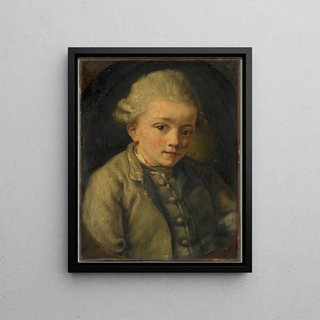Art print | Mozart - Jean-Baptiste Greuze


View from behind

Frame (optional)
Reproduction Mozart - Jean-Baptiste Greuze – Captivating Introduction
The artwork "Mozart - Jean-Baptiste Greuze" serves as a window into the fascinating world of 18th-century music and art. This painting, which immortalizes the renowned composer Wolfgang Amadeus Mozart, evokes not only the beauty of classical music but also the richness of human emotions. The scene depicted by Greuze, with its gentle light and delicate colors, transports the viewer to a suspended moment where the harmony of sounds and faces blends with rare elegance. This painting is much more than a simple representation: it is an invitation to feel the passion and creativity that marked this era.
Style and uniqueness of the artwork
Greuze's style is distinguished by an intimate approach and meticulous attention to detail. In "Mozart," every brushstroke seems charged with meaning, and each facial expression is carefully crafted to convey a precise emotion. The composition, balanced and harmonious, highlights the face of the composer, illuminated by a soft light that emphasizes his contemplative gaze. The drapery of his clothing, rendered with remarkable finesse, adds a tactile dimension to the work. Greuze, master of portraiture, succeeds in capturing not only Mozart's physical appearance but also the very essence of his personality, marked by creative intensity and deep sensitivity. This work bears witness to an era when art and music nourished each other, creating an atmosphere of mutual inspiration.
The artist and his influence
Jean-Baptiste Greuze, an emblematic figure of the Rococo movement, distinguished himself by his ability to tell stories through his paintings. Born in 1725, he quickly established himself as one of the most prominent portraitists of his time. His work had a significant influence on his contemporaries and paved the way for generations of artists. Greuze was able to capture the human soul, revealing the deepest emotions of his subjects, which generated great interest in the artistic community. His innovative approach, blending realism and idealization, allowed him to create works of profound psychological depth. By celebrating figures like Mozart, Greuze

Matte finish

View from behind

Frame (optional)
Reproduction Mozart - Jean-Baptiste Greuze – Captivating Introduction
The artwork "Mozart - Jean-Baptiste Greuze" serves as a window into the fascinating world of 18th-century music and art. This painting, which immortalizes the renowned composer Wolfgang Amadeus Mozart, evokes not only the beauty of classical music but also the richness of human emotions. The scene depicted by Greuze, with its gentle light and delicate colors, transports the viewer to a suspended moment where the harmony of sounds and faces blends with rare elegance. This painting is much more than a simple representation: it is an invitation to feel the passion and creativity that marked this era.
Style and uniqueness of the artwork
Greuze's style is distinguished by an intimate approach and meticulous attention to detail. In "Mozart," every brushstroke seems charged with meaning, and each facial expression is carefully crafted to convey a precise emotion. The composition, balanced and harmonious, highlights the face of the composer, illuminated by a soft light that emphasizes his contemplative gaze. The drapery of his clothing, rendered with remarkable finesse, adds a tactile dimension to the work. Greuze, master of portraiture, succeeds in capturing not only Mozart's physical appearance but also the very essence of his personality, marked by creative intensity and deep sensitivity. This work bears witness to an era when art and music nourished each other, creating an atmosphere of mutual inspiration.
The artist and his influence
Jean-Baptiste Greuze, an emblematic figure of the Rococo movement, distinguished himself by his ability to tell stories through his paintings. Born in 1725, he quickly established himself as one of the most prominent portraitists of his time. His work had a significant influence on his contemporaries and paved the way for generations of artists. Greuze was able to capture the human soul, revealing the deepest emotions of his subjects, which generated great interest in the artistic community. His innovative approach, blending realism and idealization, allowed him to create works of profound psychological depth. By celebrating figures like Mozart, Greuze






